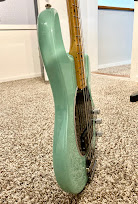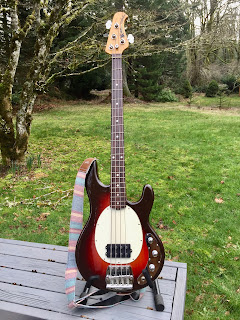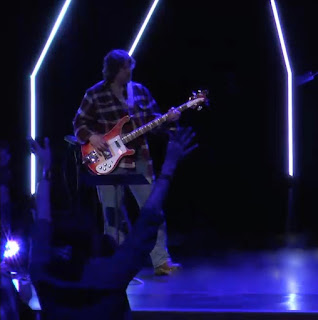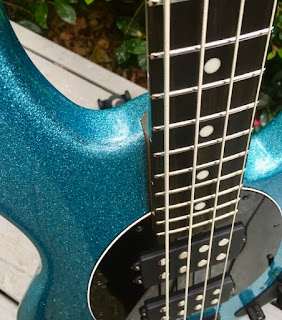It's Christmas Eve 2020; my wife and I are relaxing in front of the TV. Surfing the web on my iPad, I'm exploring the world of Music Man's Bongo; a bass that grabs the attention of players & non-players alike.
 |
| Well, it's different than... any other! |
Sitting next to each other, she watches me scroll through the photos and surprisingly began asking questions about the strange looking bass. Stumbling upon a used Firmest-Purple 4-string, single pickup model for sale, and seeing its low price she says to me, "Merry Christmas! Click on the By Now button before someone else does." Truly a Christmas miracle!
Ever since the Bongo's introduction in 2003, I was intrigued by the futuristic looking instrument. It's design was so different than anything else, that it created a lot of waves in the music community; for better or worse. Among the popular criticisms: "It looks like a toilet seat..." "It's Qbert with strings!" For those unencumbered by traditional design, and open to something new, this bass was a breath of fresh air. After all, why does every bass have to be a Fender Shaped Object? While I really liked the Bongo design, I knew my bandmates would chase me out the door-- swiftly! That was then...
...Now, almost two decades later and with a new band, I was excited to take the Bongo out for a spin.
 |
| A rare-bird today; unofficially discontinued 4H |
Details:
Under the hood, a 3-band 18v preamp powering a single neodymium magnet humbucker (opposed to the traditional ceramic, or alnico). That combo was very unique at the time. Now, 18V preamps are common, and even the new StingRay Special features an 18v preamp (different design in the 'Ray), and neodymium pickups.
It's important to note that there are two different versions of the Bongo:
- 4H (single pickup) has a three-band preamp.
- 4HH (2-pickup) has a four-band with a stacked high/low mid control.
Additionally, an important feature that flys under the radar, is that the 4H model positions its pickup further from the bridge than that of the 4HH model. This unique feature further makes the 4H tone distinct.
Fit & Finish
My Bongo finally arrived in early Jan 2021. Being played for two years by the original owner, the bass proudly boasts a few battle scares. Most require a second look to find.  |
| A few scars, yes-- but check out that paint! |
The knobs breeze past their indents, but again it's nothing to be concerned about as everything works wonderfully. Finished in a glossy, slightly metallic purple which covers the bass top to bottom, the neck is satin for comfortable playing. Fingerboard is rosewood, and the frets surprisingly don't show any wear(!) A five-bolt cutaway neck heel keeps everything stable. Everything from the tuning keys to the bridge saddles have a high quality feel. Like most all Music Man instruments, the truss-rod adjustment is the easiest of any other manufacturer.
 |
| That long, deep bevel-- serious comfort |
Feel & Sound:
Tone is subjective, but most will agree that the Bongo sounds great! It's tough to get a bad sound from it-- in fact, I haven't found one! Strung with stainless steel strings of an unknown origin, setting the cut/boost tone controls on center with volume on full, the Bongo has a full and aggressive tone.
Adjusting the preamp controls easily tames the aggressiveness, while further tweaking the tone controls give the tone even more bite and punch. Headroom is seriously impacted with the 18v system; returning to a 9v, or passive bass after playing the Bongo for a few hours makes the others feel quite... lacking. The trick here is to play those basses first-- then reach for the Bongo. Up, up and away!
Living with it:
Since the Bongo arrived in the middle of our state's Covid-Lockdown, I had a lot of time during the past 13-months to seriously play and discover what it has to offer. Soon after it's arrival I changed the strings to DR Pure Blues to tame the neutral setting a bit. It also sweetened up the tone.
 |
| 3-Band Pre with 18v of Power! |
Such a noticeable difference after the string change, along with such an interactive preamp, makes me believe these basses were designed to be sensitive to the player's input. That sensitivity makes for a great instrument to explore, with so many more tones available compared to other single-pickup basses.
Playing for a few hours with a normal guitar strap gets uncomfortable, as the bass weighs just under 10 pounds. After installing a set of Dunlop Straplcoks I was able to use my favorite wide strap which eliminated the discomfort. Speaking of comfort, the body is contoured along the full upper edge with a deep bevel allowing the players arm to rest comfortably when playing.
Having a few nice basses to play, I find myself reaching for the Bongo when at home practicing for the weekend service. There's something about the Bongo that allows me to simply plug & play, without having to think much about the preamp settings. Everything about the bass is just comfortable-- especially during those long rehearsals, or practice sessions.  |
| "Samurai Bassist." It is the way |
On stage, it's always easy to dial in a tone that cuts through while remaining full bodied. No matter the complement of instruments on stage; keyboards, a pair of electric guitars, heavy playing drummer, acoustic guitars, violin, male & female singers-- the Bongo can fit into any combination. Lately our typical band has been simply an acoustic guitarist, a male and female vocalist and occasionally a keyboardist. In this setting, the Bongo easily fills the bottom end with clarity.
Since we don't have a drummer, I try to enhance the bottom end as much as possible without being boomy. With that goal in mind, I recently installed a set of D'Addario Chromes flat-wound strings.
 |
| A match made in Heaven |
Doing so enhanced the fullness of the tone, and fattened up the D and G strings. Remember, this bass is sensitive to minor changes, so going from rounds to flats-- even though they are modern flats-- took this bass to another level of goodness. It's tough to accurately describe how full, clear and punchy this combination of a Bongo wearing Chromes can be. While the flats do take away some of the high end in the neutral setting, the preamp has such a wide range that I can regain those lost highs and still retain that full, fundamental of the flats. It's a wonderful thing!
It's design having been around for nearly 20-years now, the Bongo has settled in as an accepted instrument, ridiculed only by the hardest-hearted bassists who simply can't let go of the past. My current bandmates think the Bongo looks great and often complement me on its sound. Kids often approach the stage when we are packing up to ask questions about it, and express their desire to learn to play-- because the look of the bass! Every time that happens I'm transported back to my first time seeing Geddy Lee playing his Rickenbacker 4001, and being struck by such a cool looking guitar-- and that sound(!).  |
| Geddy Lee "Exit Stage Left" |
It was Geddy and his bass that stoked that flame of desire within me to take up music. The thought that my Bongo might inspire the next generation is worth more than I can put into words.
Should you find yourself considering a Bongo of your own, but still have questions, feel free to ask away! Until next time...
...Stay tuned & in tune!





































